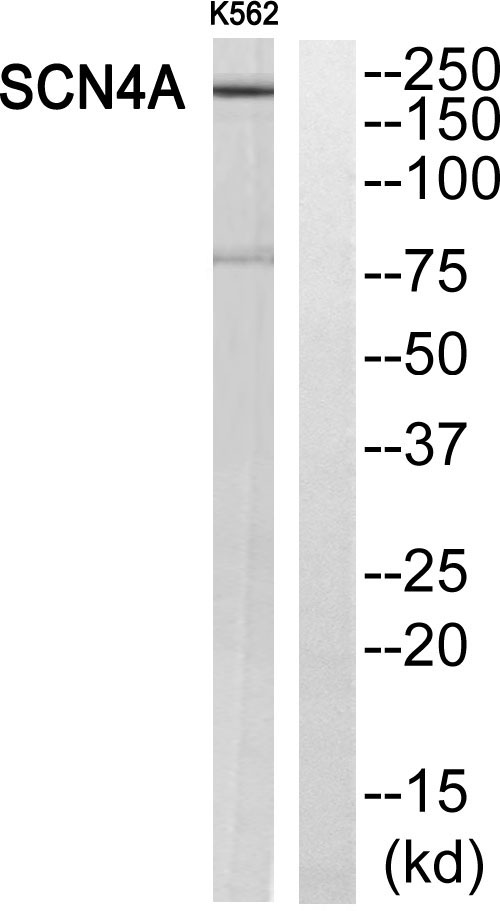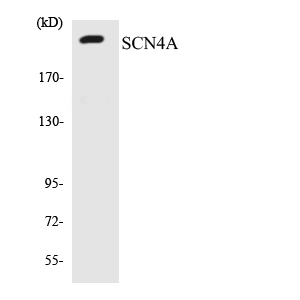产品名称
Na+ CP type IVα Rabbit Polyclonal Antibody
别名
SCN4A; Sodium channel protein type 4 subunit alpha; SkM1; Sodium channel protein skeletal muscle subunit alpha; Sodium channel protein type IV subunit alpha; Voltage-gated sodium channel subunit alpha Nav1.4
蛋白名称
Sodium channel protein type 4 subunit alpha
存储缓冲液
Liquid in PBS containing 50% glycerol, 0.5% BSA and 0.02% New type preservative N.
Human Gene Link
http://www.ncbi.nlm.nih.gov/sites/entrez?db=gene&term=6329
Human Swissprot No.
P35499
Human Swissprot Link
http://www.uniprot.org/uniprotkb/P35499/entry
Mouse Gene Link
http://www.ncbi.nlm.nih.gov/sites/entrez?db=gene&term=110880
Mouse Swissprot No.
Q9ER60
Mouse Swissprot Link
http://www.uniprot.org/uniprot/Q9ER60
Rat Gene Link
http://www.ncbi.nlm.nih.gov/sites/entrez?db=gene&term=25722
Rat Swissprot Link
http://www.uniprot.org/uniprot/P15390
免疫原
The antiserum was produced against synthesized peptide derived from human SCN4A. AA range:431-480
特异性
Na+ CP type IVα Polyclonal Antibody detects endogenous levels of Na+ CP type IVα protein.
稀释度
WB 1:500-2000;IHC-p 1:50-300
宿主
Polyclonal, Rabbit,IgG
背景介绍
Voltage-gated sodium channels are transmembrane glycoprotein complexes composed of a large alpha subunit with 24 transmembrane domains and one or more regulatory beta subunits. They are responsible for the generation and propagation of action potentials in neurons and muscle. This gene encodes one member of the sodium channel alpha subunit gene family. It is expressed in skeletal muscle, and mutations in this gene have been linked to several myotonia and periodic paralysis disorders. [provided by RefSeq, Jul 2008],
细胞定位
Cell membrane ; Multi-pass membrane protein .
功能
disease:Defects in SCN4A are a cause of periodic paralysis hypokalemic (HOKPP) [MIM:170400]; also designated HYPOPP. HOKPP is an autosomal dominant disorder manifested by episodic flaccid generalized muscle weakness associated with falls of serum potassium levels.,disease:Defects in SCN4A are the cause of a congenital myasthenic syndrome due to mutation in SCNA4 (CMSSCNA4) [MIM:603967]. CMSSCNA4 is a congenital myasthenic syndrome associated with fatigable generalized weakness and recurrent attacks of respiratory and bulbar paralysis since birth. The fatigable weakness involves lid-elevator, external ocular, facial, limb and truncal muscles and an decremental response of the compound muscle action potential on repetitive stimulation.,disease:Defects in SCN4A are the cause of myotonia SCN4A-related (MYOSCN4A) [MIM:608390]. Myotonia is characterized by sustained muscle tensing that prevents muscles from relaxing normally. Myotonia causes muscle stiffness that can interfere with movement. In some people the stiffness is very mild, while in other cases it may be severe enough to interfere with walking, running, and other activities of daily life. MYOSCN4A is a phenotypically highly variable myotonia aggravated by potassium loading, and often by cold. MYOSCN4A includes myotonia permanens and myotonia fluctuans. In myotonia permanens, the myotonia is generalized and there is a hypertrophy of the muscle, particularly in the neck and the shoulder. Attacks of severe muscle stiffness of the thoracic muscles may be life threatening due to impaired ventilation. In myotonia fluctuans, the muscle stiffness may fluctuate from day to day, provoked by exercise.,disease:Defects in SCN4A are the cause of paramyotonia congenita of von Eulenburg (PMC) [MIM:168300]. PMC is an autosomal dominant channelopathy characterized by myotonia, increased by exposure to cold, intermittent flaccid paresis, not necessarily dependent on cold or myotonia, lability of serum potassium, nonprogressive nature and lack of atrophy or hypertrophy of muscles. In some patients, myotonia is not increased by cold exposure (paramyotonia without cold paralysis). Patients may have a combination phenotype of PMC and HYPP.,disease:Defects in SCN4A are the cause of periodic paralysis hyperkalemic (HYPP) [MIM:170500]. HYPP is an autosomal dominant channelopathy characterized by episodic flaccid generalized muscle weakness associated with high levels of serum potassium. Concurrence of myotonia is found in HYPP patients.,disease:Defects in SCN4A are the cause of periodic paralysis normokalemic (NKPP) [MIM:170500]. NKPP is a disorder closely related to hyperkalemic periodic paralysis, but marked by a lack of alterations in potassium levels during attacks of muscle weakness.,domain:The sequence contains 4 internal repeats, each with 5 hydrophobic segments (S1,S2,S3,S5,S6) and one positively charged segment (S4). Segments S4 are probably the voltage-sensors and are characterized by a series of positively charged amino acids at every third position.,function:This protein mediates the voltage-dependent sodium ion permeability of excitable membranes. Assuming opened or closed conformations in response to the voltage difference across the membrane, the protein forms a sodium-selective channel through which Na(+) ions may pass in accordance with their electrochemical gradient. This sodium channel may be present in both denervated and innervated skeletal muscle.,online information:SCN4A entry,similarity:Belongs to the sodium channel family.,similarity:Contains 1 IQ domain.,subunit:Muscle sodium channels contain an alpha subunit and a smaller beta subunit. Interacts with the PDZ domain of the syntrophin SNTA1, SNTB1 and SNTB2.,
纯化
The antibody was affinity-purified from rabbit antiserum by affinity-chromatography using epitope-specific immunogen.


